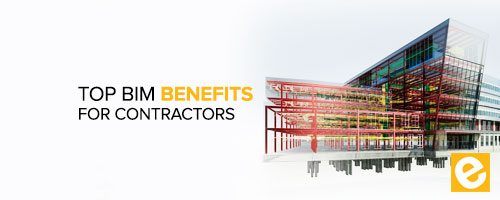
List of Construction BIM Benefits for Contractors
Building Information Modeling (BIM) utilizes a 3D visual representation to plan, design, and collaborate during the construction lifecycle. Similar to other construction technology, BIM has been around for a while but is starting to gain traction. The advancements of mobile devices and cloud-based software are facilitating the adoption of technology by contractors. Adoption of BIM by contractors is increasing as more contractors are looking for ways to deliver projects faster and better.
Table of Contents
B: Building as a Process
Designers and contractors utilize BIM software to create models for buildings. However, many contractors utilize BIM for infrastructure projects also. BIM is more than just drawings and models. In fact, BIM provides value to contractors when thought of as the process of building. BIM as a process brings all the stakeholders together to communicate around the model. With the model as the center point of a project, BIM benefits contractors by facilitating a more collaborative building process.

I: Information Brings the Model to Life
The foundation of a successful construction project is the ability to seamlessly capture, share and manage information. Utilizing BIM along with a common data environment creates a center point for all project information to facilitate a process for smart building. Contractors work most effectively when provided with the most amount of data and details that 3D models provide. Similarly, during the construction process, contractors enter their own information in terms of product information and jobsite activity within the common data environment. If there are any questions, contractors can enter RFIs or Change Orders directly into the model for architects to review. The collaboration within the model provides direct communication between subcontractors, architects, and owner, for quick decision-making and less rework. BIM comes to life as more than a 3D model. BIM benefits contractors by creating a model full of data and project information.
M: Model for Maintenance
The model, is key to all phases of the build process – preconstruction, construction, and post construction. BIM along with the common data environment gets handed off to owners post construction. It serves as an information hub for building owners and facility managers. The data provided during construction becomes the resource for facility managers to reference for building maintenance and owners for renovations or expansion. As a true to life representation of the actual building, the model shows what is behind the walls – specific information on valves, part numbers, etc. and interior materials.
BIM throughout the Construction Process
Because BIM is critical in improving the process of construction, then of course, subcontractors who perform 80-100% of the labor should be part of the BIM process. BIM benefits for contractors can be found throughout the construction process:
Preconstruction
Collaboration is key to BIM. Therefore, the optimal use of BIM during preconstruction is for the subcontractors to work alongside the designer to create the model. This will lay the foundation of connecting the subject matter experts (subcontractors) with the designers. Owners and the design team can align expectations directly with the subcontractors, to provide more accurate cost estimates and schedules. BIM benefits for contractors include providing an accurate visual representation for the subcontractor to validate costs and manage risk. The team catches any design errors or omissions before construction starts to minimize rework.
Construction
During the construction phase, BIM serves as the information resource for the project team. The foreman and field team have access to the model for task assignment. All work completed will be updated to the model to show project progression. When the subcontractor enters labor productivity information, the team links BIM to the schedule for better coordination and transparency on project progression. When any changes are made to the model, the entire team becomes fully aware of the cost and schedule implications of design changes.
Post-construction
Many subcontractors also provide service and maintenance on the systems they install. With BIM, facility managers, contractors and service technicians can quickly resolve any issues by referring to the BIM. Detailed information about all the building components are within the model – such as product information, model, and part number, etc. Facility managers can work alongside subcontractors to proactively maintain the building before parts break down. This allows owners to control the costs over the buildings life span not just during the construction phase.
BIM and common data environment serve as the single source of truth to bring all project stakeholders together. It is critical that subcontractors participate as early as possible in project discussions. This partnership of subcontractors with building owners, designers and architects and general contractors delivers projects within budget and schedule. BIM provides a higher level of detail and collaboration for subcontractors to ensure that errors are caught, expectations are aligned, and cost estimates and schedules are accurate. Integrating labor delivery and the subject matter expertise from subcontractors achieves better business results for all project stakeholders.
Reach out today to schedule a demo and learn how eSUB can transform your business into a well-oiled construction project tracking machine!